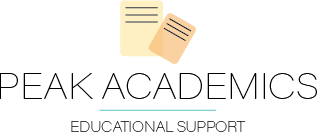Setting goals increases motivation and helps children develop a sense of self. Children who practice reflection are more likely to self-monitor and adjust, increasing their potential to meet their objectives. Self-monitoring techniques combine reflection, mindfulness, and strategy, allowing students to analyze their progress toward a specific goal and plan their next steps.
Self-monitoring can be a multi-step process, which may cause children to feel overwhelmed or stuck. But with the right tools and guidance, children can learn to self-monitor on their own!
Create a Goal
An attainable goal is the foundation of self-monitoring. Without a goal, children have nothing to evaluate, compare, or monitor. This goal could focus on executive functions like organization, academic skills, or behavior-based objectives.
Define Mastery
How will your child know they’ve mastered this goal? What should they know, and what should they be able to do independently? What does success look like—and sound like?
For example, if a student’s goal is “to keep their room clean,” how often does it need to happen for mastery to be achieved? What exactly does a “clean room” mean? Adding specific, measurable details can help avoid vague expectations. For example: “I can keep my room clean 6 out of 7 days each week.”
Break It Down
Break the goal into smaller steps or chunks. Ask questions like:
“What skills do you need to reach your goal?”
“How do you complete this process?”
“What needs to happen first, next, and last?”
For example, writing CVC words includes multiple skills: letter formation, segmenting words, letter-sound correspondence, and understanding vowels and consonants. Breaking the goal into smaller pieces helps students see where they are in the process of meeting their objective.
Monitor Goals
Once children have created a goal, defined mastery, and broken it down into steps, they’re ready to start self-monitoring. Try a combination of these strategies to see what works best for your child’s needs and independence level:
Create a checklist using “I can” or “I will” statements for each sub-skill within the goal. Children can refer to these to see where they are in the process.
Reflect each day for 10–15 minutes by writing or thinking aloud. Guiding questions like “What went well?” “What still needs improvement?” and “What is your focus for tomorrow?” can help direct their thoughts and encourage adjustment.
Check in with your child daily to help them stay accountable for their progress and growth. Ask goal-focused questions, offer reminders, and revisit their goals at different times throughout the day.
Use visual aids and supports to help your child remember the steps involved in reaching their goal. Let your child participate in designing the visual to increase ownership.
Celebrate small successes along the way to keep motivation high and highlight their progress toward the goal.
Goals can measure a variety of skills, behaviors, and abilities. It’s important to recognize that each goal involves a process with multiple steps so children can reflect on their achievements and plan their next moves. Teachers can play an important role in setting academic goals and may be a helpful resource when developing sub-objectives for your child. As your child masters their goals, continue setting new ones to expand their understanding, responsibility, and growth!
Written by Ami Z.

